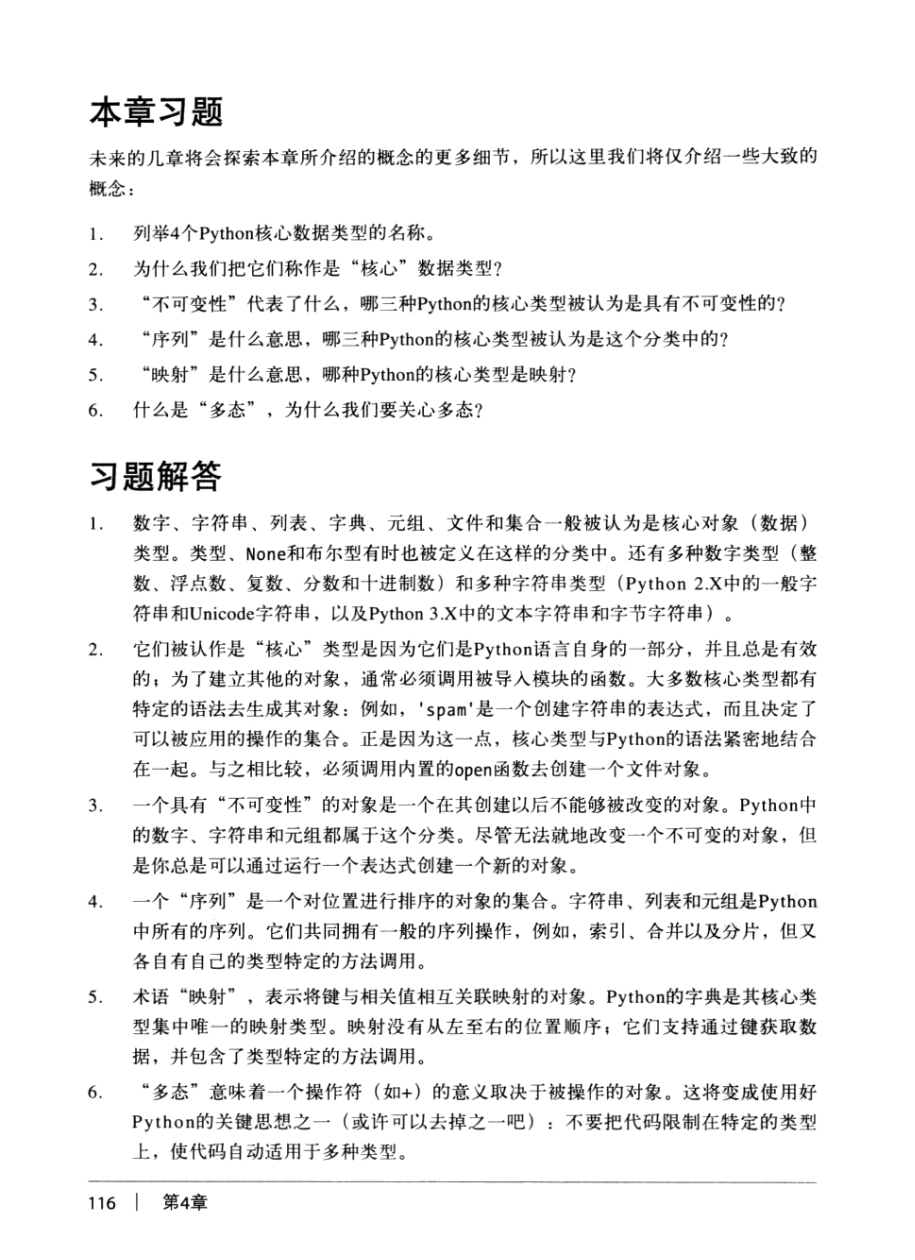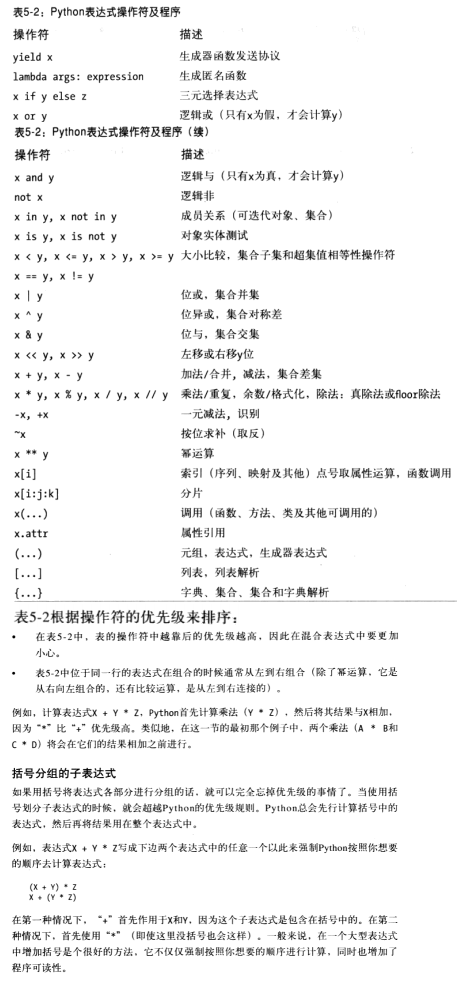1 什么是数据?
x=10,10是我们要存储的数据
2 为何数据要分不同的类型
数据是用来表示状态的,不同的状态就应该用不同的类型的数据去表示
3 数据类型
数字(整形,长整形,浮点型,复数)
字符串
字节串:在介绍字符编码时介绍字节bytes类型
列表
元组
字典
集合
4 按照以下几个点展开数据类型的学习
#一:基本使用
1 用途
2 定义方式
3 常用操作+内置的方法
#二:该类型总结
1 存一个值or存多个值
只能存一个值
可以存多个值,值都可以是什么类型
2 有序or无序
3 可变or不可变
!!!可变:值变,id不变。可变==不可hash
!!!不可变:值变,id就变。不可变==可hash
数字
整型与浮点型
#整型int
作用:年纪,等级,身份证号,qq号等整型数字相关
定义:
age=10 #本质age=int(10)
#浮点型float
作用:薪资,身高,体重,体质参数等浮点数相关
salary=3000.3 #本质salary=float(3000.3)
#二进制,十进制,八进制,十六进制
其他数字类型(了解)
#长整形(了解)
在python2中(python3中没有长整形的概念):
>>> num=2L
>>> type(num)
<type 'long'>
#复数(了解)
>>> x=1-2j
>>> x.real
1.0
>>> x.imag
-2.0
内置数学函数
pow,abs,round,int,hex,oct,bin等
公用模块
math,random
字符串
#作用:名字,性别,国籍,地址等描述信息 #定义:在单引号双引号三引号内,由一串字符组成 name='egon' #优先掌握的操作: #1、按索引取值(正向取+反向取) :只能取 #2、切片(顾头不顾尾,步长) #3、长度len #4、成员运算in和not in #5、移除空白strip #6、切分split #7、循环
需要掌握的操作
#1、strip,lstrip,rstrip #2、lower,upper #3、startswith,endswith #4、format的三种玩法 #5、split,rsplit #6、join #7、replace #8、isdigit
#strip
name='*egon**'
print(name.strip('*'))
print(name.lstrip('*'))
print(name.rstrip('*'))
#lower,upper
name='egon'
print(name.lower())
print(name.upper())
#startswith,endswith
name='alex_SB'
print(name.endswith('SB'))
print(name.startswith('alex'))
#format的三种玩法
res='{} {} {}'.format('egon',18,'male')
res='{1} {0} {1}'.format('egon',18,'male')
res='{name} {age} {sex}'.format(sex='male',name='egon',age=18)
#split
name='root:x:0:0::/root:/bin/bash'
print(name.split(':')) #默认分隔符为空格
name='C:/a/b/c/d.txt' #只想拿到顶级目录
print(name.split('/',1))
name='a|b|c'
print(name.rsplit('|',1)) #从右开始切分
#join
tag=' '
print(tag.join(['egon','say','hello','world'])) #可迭代对象必须都是字符串
#replace
name='alex say :i have one tesla,my name is alex'
print(name.replace('alex','SB',1))
#isdigit:可以判断bytes和unicode类型,是最常用的用于于判断字符是否为"数字"的方法
age=input('>>: ')
print(age.isdigit())
示例
#1、find,rfind,index,rindex,count
#2、center,ljust,rjust,zfill
#3、expandtabs
#4、captalize,swapcase,title
#5、is数字系列
#6、is其他
#find,rfind,index,rindex,count
name='egon say hello'
print(name.find('o',1,3)) #顾头不顾尾,找不到则返回-1不会报错,找到了则显示索引
# print(name.index('e',2,4)) #同上,但是找不到会报错
print(name.count('e',1,3)) #顾头不顾尾,如果不指定范围则查找所有
#center,ljust,rjust,zfill
name='egon'
print(name.center(30,'-'))
print(name.ljust(30,'*'))
print(name.rjust(30,'*'))
print(name.zfill(50)) #用0填充
#expandtabs
name='egon hello'
print(name)
print(name.expandtabs(1))
#captalize,swapcase,title
print(name.capitalize()) #首字母大写
print(name.swapcase()) #大小写翻转
msg='egon say hi'
print(msg.title()) #每个单词的首字母大写
#is数字系列
#在python3中
num1=b'4' #bytes
num2=u'4' #unicode,python3中无需加u就是unicode
num3='四' #中文数字
num4='Ⅳ' #罗马数字
#isdigt:bytes,unicode
print(num1.isdigit()) #True
print(num2.isdigit()) #True
print(num3.isdigit()) #False
print(num4.isdigit()) #False
#isdecimal:uncicode
#bytes类型无isdecimal方法
print(num2.isdecimal()) #True
print(num3.isdecimal()) #False
print(num4.isdecimal()) #False
#isnumberic:unicode,中文数字,罗马数字
#bytes类型无isnumberic方法
print(num2.isnumeric()) #True
print(num3.isnumeric()) #True
print(num4.isnumeric()) #True
#三者不能判断浮点数
num5='4.3'
print(num5.isdigit())
print(num5.isdecimal())
print(num5.isnumeric())
'''
总结:
最常用的是isdigit,可以判断bytes和unicode类型,这也是最常见的数字应用场景
如果要判断中文数字或罗马数字,则需要用到isnumeric
'''
#is其他
print('===>')
name='egon123'
print(name.isalnum()) #字符串由字母或数字组成
print(name.isalpha()) #字符串只由字母组成
print(name.isidentifier())
print(name.islower())
print(name.isupper())
print(name.isspace())
print(name.istitle())
列表
#作用:多个装备,多个爱好,多门课程,多个女朋友等
#定义:[]内可以有多个任意类型的值,逗号分隔
my_girl_friends=['alex','wupeiqi','yuanhao',4,5] #本质my_girl_friends=list([...])
或
l=list('abc')
#优先掌握的操作:
#1、按索引存取值(正向存取+反向存取):即可存也可以取
#2、切片(顾头不顾尾,步长)
#3、长度
#4、成员运算in和not in
#5、追加
#6、删除
#7、循环
#ps:反向步长
l=[1,2,3,4,5,6]
#正向步长
l[0:3:1] #[1, 2, 3]
#反向步长
l[2::-1] #[3, 2, 1]
#列表翻转
l[::-1] #[6, 5, 4, 3, 2, 1]
元组
#作用:存多个值,对比列表来说,元组不可变(是可以当做字典的key的),主要是用来读 #定义:与列表类型比,只不过[]换成() age=(11,22,33,44,55)本质age=tuple((11,22,33,44,55)) #优先掌握的操作: #1、按索引取值(正向取+反向取):只能取 #2、切片(顾头不顾尾,步长) #3、长度 #4、成员运算in和not in #5、循环
字典
#作用:存多个值,key-value存取,取值速度快
#定义:key必须是不可变类型,value可以是任意类型
info={'name':'egon','age':18,'sex':'male'} #本质info=dict({....})
或
info=dict(name='egon',age=18,sex='male')
或
info=dict([['name','egon'],('age',18)])
或
{}.fromkeys(('name','age','sex'),None)
{'age': None, 'name': None, 'sex': None}
#优先掌握的操作: #1、按key存取值:可存可取 #2、长度len #3、成员运算in和not in #4、删除 #5、键keys(),值values(),键值对items() #6、循环
集合
#作用:去重,关系运算,
#定义:
知识点回顾
可变类型是不可hash类型
不可变类型是可hash类型
#定义集合:
集合:可以包含多个元素,用逗号分割,
集合的元素遵循三个原则:
1:每个元素必须是不可变类型(可hash,可作为字典的key)
2:没有重复的元素
3:无序
注意集合的目的是将不同的值存放到一起,不同的集合间用来做关系运算,无需纠结于集合中单个值
#优先掌握的操作:
#1、长度len
#2、成员运算in和not in
#3、|合集
#4、&交集
#5、-差集
#6、^对称差集
#7、==
#8、父集:>,>=
#9、子集:<,<=
数据类型总结
按存储空间的占用分(从低到高)
数字 字符串 集合:无序,即无序存索引相关信息 元组:有序,需要存索引相关信息,不可变 列表:有序,需要存索引相关信息,可变,需要处理数据的增删改 字典:无序,需要存key与value映射的相关信息,可变,需要处理数据的增删改
按存值个数区分
| 标量/原子类型 | 数字,字符串 |
| 容器类型 | 列表,元组,字典 |
按可变不可变区分
| 可变 | 列表,字典 |
| 不可变 | 数字,字符串,元组 |
按访问顺序区分
| 直接访问 | 数字 |
| 顺序访问(序列类型) | 字符串,列表,元组 |
| key值访问(映射类型) | 字典 |

Python表达式操作符及程序

#作业一: 三级菜单
#要求:
打印省、市、县三级菜单
可返回上一级
可随时退出程序

menu = { '北京':{ '海淀':{ '五道口':{ 'soho':{}, '网易':{}, 'google':{} }, '中关村':{ '爱奇艺':{}, '汽车之家':{}, 'youku':{}, }, '上地':{ '百度':{}, }, }, '昌平':{ '沙河':{ '老男孩':{}, '北航':{}, }, '天通苑':{}, '回龙观':{}, }, '朝阳':{}, '东城':{}, }, '上海':{ '闵行':{ "人民广场":{ '炸鸡店':{} } }, '闸北':{ '火车战':{ '携程':{} } }, '浦东':{}, }, '山东':{}, } tag=True while tag: menu1=menu for key in menu1: # 打印第一层 print(key) choice1=input('第一层>>: ').strip() # 选择第一层 if choice1 == 'b': # 输入b,则返回上一级 break if choice1 == 'q': # 输入q,则退出整体 tag=False continue if choice1 not in menu1: # 输入内容不在menu1内,则继续输入 continue while tag: menu_2=menu1[choice1] # 拿到choice1对应的一层字典 for key in menu_2: print(key) choice2 = input('第二层>>: ').strip() if choice2 == 'b': break if choice2 == 'q': tag = False continue if choice2 not in menu_2: continue while tag: menu_3=menu_2[choice2] for key in menu_3: print(key) choice3 = input('第三层>>: ').strip() if choice3 == 'b': break if choice3 == 'q': tag = False continue if choice3 not in menu_3: continue while tag: menu_4=menu_3[choice3] for key in menu_4: print(key) choice4 = input('第四层>>: ').strip() if choice4 == 'b': break if choice4 == 'q': tag = False continue if choice4 not in menu_4: continue # 第四层内没数据了,无需进入下一层

menu = { '北京':{ '海淀':{ '五道口':{ 'soho':{}, '网易':{}, 'google':{} }, '中关村':{ '爱奇艺':{}, '汽车之家':{}, 'youku':{}, }, '上地':{ '百度':{}, }, }, '昌平':{ '沙河':{ '老男孩':{}, '北航':{}, }, '天通苑':{}, '回龙观':{}, }, '朝阳':{}, '东城':{}, }, '上海':{ '闵行':{ "人民广场":{ '炸鸡店':{} } }, '闸北':{ '火车战':{ '携程':{} } }, '浦东':{}, }, '山东':{}, } #part1(初步实现):能够一层一层进入 layers = [menu, ] while True: current_layer = layers[-1] for key in current_layer: print(key) choice = input('>>: ').strip() if choice not in current_layer: continue layers.append(current_layer[choice]) #part2(改进):加上退出机制 layers=[menu,] while True: if len(layers) == 0: break current_layer=layers[-1] for key in current_layer: print(key) choice=input('>>: ').strip() if choice == 'b': layers.pop(-1) continue if choice == 'q':break if choice not in current_layer:continue layers.append(current_layer[choice])
#作业二:请闭眼写出购物车程序
#需求:
用户名和密码存放于文件中,格式为:egon|egon123
启动程序后,先登录,登录成功则让用户输入工资,然后打印商品列表,失败则重新登录,超过三次则退出程序
允许用户根据商品编号购买商品
用户选择商品后,检测余额是否够,够就直接扣款,不够就提醒
可随时退出,退出时,打印已购买商品和余额

import os product_list = [['Iphone7',5800], ['Coffee',30], ['疙瘩汤',10], ['Python Book',99], ['Bike',199], ['ViVo X9',2499], ] shopping_cart={} current_userinfo=[] db_file=r'db.txt' while True: print(''' 1 登陆 2 注册 3 购物 ''') choice=input('>>: ').strip() if choice == '1': #1、登陆 tag=True count=0 while tag: if count == 3: print('�33[45m尝试次数过多,退出。。。�33[0m') break uname = input('用户名:').strip() pwd = input('密码:').strip() with open(db_file,'r',encoding='utf-8') as f: for line in f: line=line.strip(' ') user_info=line.split(',') uname_of_db=user_info[0] pwd_of_db=user_info[1] balance_of_db=int(user_info[2]) if uname == uname_of_db and pwd == pwd_of_db: print('�33[48m登陆成功�33[0m') # 登陆成功则将用户名和余额添加到列表 current_userinfo=[uname_of_db,balance_of_db] print('用户信息为:',current_userinfo) tag=False break else: print('�33[47m用户名或密码错误�33[0m') count+=1 elif choice == '2': uname=input('请输入用户名:').strip() while True: pwd1=input('请输入密码:').strip() pwd2=input('再次确认密码:').strip() if pwd2 == pwd1: break else: print('�33[39m两次输入密码不一致,请重新输入!!!�33[0m') balance=input('请输入充值金额:').strip() with open(db_file,'a',encoding='utf-8') as f: f.write('%s,%s,%s ' %(uname,pwd1,balance)) elif choice == '3': if len(current_userinfo) == 0: print('�33[49m请先登陆...�33[0m') else: #登陆成功后,开始购物 uname_of_db=current_userinfo[0] balance_of_db=current_userinfo[1] print('尊敬的用户[%s] 您的余额为[%s],祝您购物愉快' %( uname_of_db, balance_of_db )) tag=True while tag: for index,product in enumerate(product_list): print(index,product) choice=input('输入商品编号购物,输入q退出>>: ').strip() if choice.isdigit(): choice=int(choice) if choice < 0 or choice >= len(product_list):continue pname=product_list[choice][0] pprice=product_list[choice][1] if balance_of_db > pprice: if pname in shopping_cart: # 原来已经购买过 shopping_cart[pname]['count']+=1 else: shopping_cart[pname]={'pprice':pprice,'count':1} balance_of_db-=pprice # 扣钱 current_userinfo[1]=balance_of_db # 更新用户余额 print("Added product " + pname + " into shopping cart,�33[42;1myour current�33[0m balance " + str(balance_of_db)) else: print("买不起,穷逼! 产品价格是{price},你还差{lack_price}".format( price=pprice, lack_price=(pprice - balance_of_db) )) print(shopping_cart) elif choice == 'q': print(""" ---------------------------------已购买商品列表--------------------------------- id 商品 数量 单价 总价 """) total_cost=0 for i,key in enumerate(shopping_cart): print('%22s%18s%18s%18s%18s' %( i, key, shopping_cart[key]['count'], shopping_cart[key]['pprice'], shopping_cart[key]['pprice'] * shopping_cart[key]['count'] )) total_cost+=shopping_cart[key]['pprice'] * shopping_cart[key]['count'] print(""" 您的总花费为: %s 您的余额为: %s ---------------------------------end--------------------------------- """ %(total_cost,balance_of_db)) while tag: inp=input('确认购买(yes/no?)>>: ').strip() if inp not in ['Y','N','y','n','yes','no']:continue if inp in ['Y','y','yes']: # 将余额写入文件 src_file=db_file dst_file=r'%s.swap' %db_file with open(src_file,'r',encoding='utf-8') as read_f, open(dst_file,'w',encoding='utf-8') as write_f: for line in read_f: if line.startswith(uname_of_db): l=line.strip(' ').split(',') l[-1]=str(balance_of_db) line=','.join(l)+' ' write_f.write(line) os.remove(src_file) os.rename(dst_file,src_file) print('购买成功,请耐心等待发货') shopping_cart={} current_userinfo=[] tag=False else: print('输入非法') else: print('�33[33m非法操作�33[0m') 复制代码
